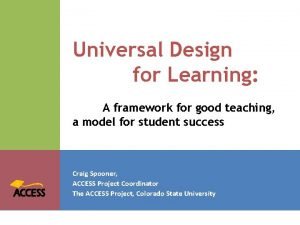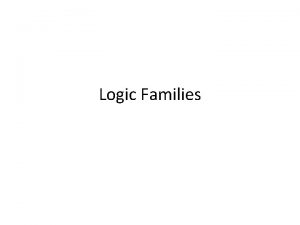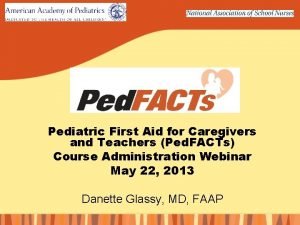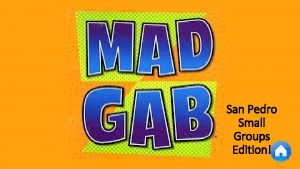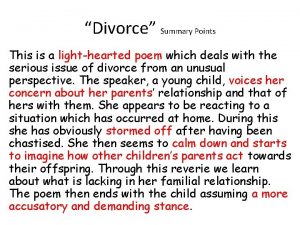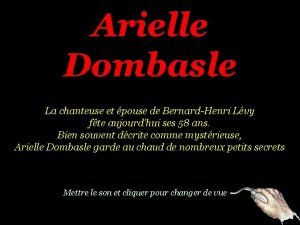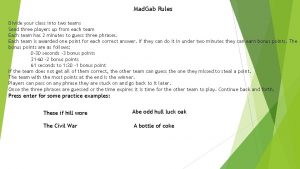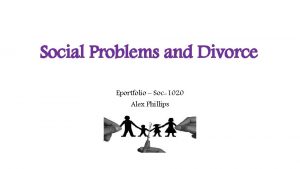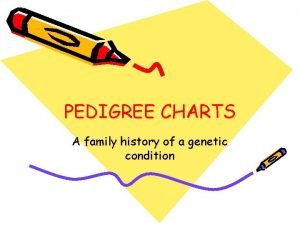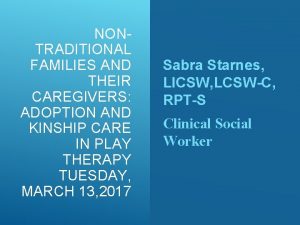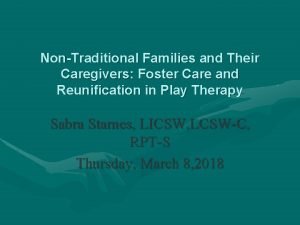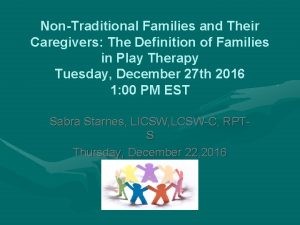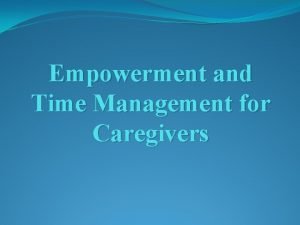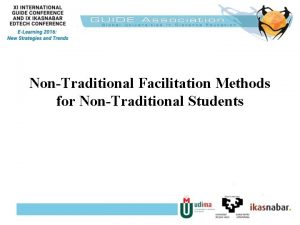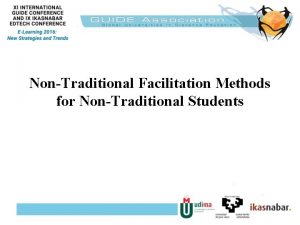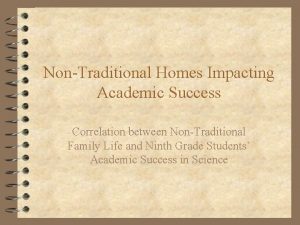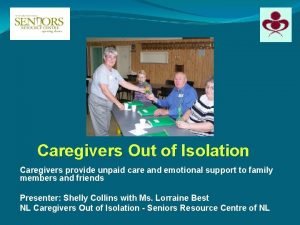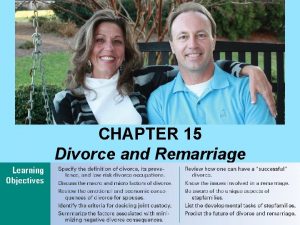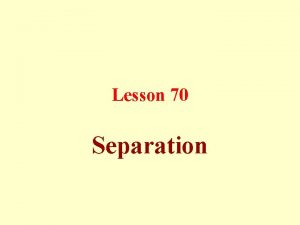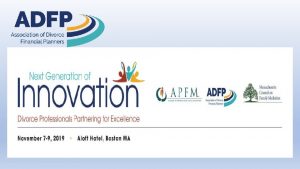NONTRADITIONAL FAMILIES AND THEIR CAREGIVERS DIVORCE AND STEPFAMILIES





































- Slides: 37

NON-TRADITIONAL FAMILIES AND THEIR CAREGIVERS: DIVORCE AND STEP-FAMILIES IN PLAY THERAPY MARCH 15, 2018 Sabra Starnes, LICSW, LCSW-C, RPT-S Clinical Social Worker

Define Divorce, single parenting, and step families LEARNING OBJECTIVES Discuss the tensions in all of these intimate relationships Provide techniques to help families navigate these realities

ROLE OF THE CAREGIVER S Divorce-Divorce, also known as dissolution of marriage, is the termination of a marriage or marital union, the canceling and/or reorganizing of the legal duties and responsibilities of marriage, thus dissolving the bonds of matrimony between a married couple under the rule of law of the particular country and/or state.

ROLE OF THE CAREGIVERS Step families-These families take a multitude of forms: Divorced with children; the children reside with one parent and visit the other. Most are dating or looking for new partners. Remarried, re-coupled, living together, with his and/or her children; He/she is in the role of stepparent. Single Mothers; recoupled, dating and alone. Divorced Dads; these dads generally visit their children. Often they are recoupled, bringing a stepmother figure into their children’s lives.

STATISTICS In 2014 there were 813, 862 divorces in the United States Source: CDC/NCHS National Vital Statistics System.

STATISTICS FOR THE NUMBER STEPFAMILIES IN US • These families take a multitude of forms: • Divorced with children; the children reside with one parent and visit the other. Most are dating or looking for new partners. • Remarried, re-coupled, living together, with his and/or her children; He/she is in the role of stepparent. • Single Mothers; re-coupled, dating and alone. • Divorced Dads; these dads generally visit their children. Often they are re-coupled, bringing a stepmother figure into their children’s lives. • Lesbian and gay couples with children from a prior relationship.



IMPACT ON DIVORCE ON CHILDREN Determining Factors: • Child’s age, gender, development • Pre-existing issues: Special Needs, • Adoption, Trauma • Quality of Parent Child Relationship • Number of Transitions; moves, schedule changes, re-marriage, multiple legal battles

Families may often seek family therapy to…. • To get help and support for the children Clarify divorce-related misconceptions • Increase ability to communicate openly • Facilitate appropriate expression of feelings • Strengthen effective coping skills • Eliminate self-blame for the divorce • Resolve reunification fantasies

Parents put the child in the middle of the conflict Parent alienation Settling financial and custodial disagreements On going battles HIGH CONFLICT DIVORCES

CHALLENGES AND REWARDS DOING CHECKINS WITH PARENTS

THERAPEUTIC THEMES AND ISSUES • • • Shock and Disbelief Adjustment Denial Separation Anxiety Chaos, loss of control loneliness Change Loss Turmoil

THEORIES OF PLAY THERAPY Non-Directive Child-centered Cognitive behavioral Jungian Gestalt Psychoanalytic Developmental Sand tray Solution Focused - Source: In. APT conference 2005

EXTENDED PLAY-BASED DEVELOPMENTAL ASSESSMENTS CLINICIANS GUIDE Created and developed b Eliana Gil Extended Play-Based Developmental Assessments are designed to determine children’s overall functioning; identify current clinical symptoms; identify trauma impact, if any; assess children’s perceptions of parental support and guidance; and determine children’s perceptions of their internal and external resources. Clinicians who conduct EPBDA observe and address a variety of domains including physical functioning, patterns of relational interactions, thematic material in their play, and externalized concerns. A variety of directive and non-directive techniques are utilized avoiding suggestive language or questioning and allowing children to feel comfortable enough to volunteer relevant information about their world.

THERAPEUTIC THEMES AND ISSUES • • Acceptance Appearance of Normal fear of one parent not being there Toys all over the place constant change Broken, dead, gone Never-ending Battles Peace

METHODS OF PLAY THERAPY Sand Tray Imaginative Play Puppet Play Art/Crafts Bibilo therapy Psychodrama Therapeutic Games

Recommended Directive Play therapy techniques to use throughout treatment by Paris Goodyear-Brown

Recommended Directive Play therapy techniques to use throughout treatment by Liana Lowestein

Nurturing Toys Client’s can use these to play out family relationships and events Doll house, dolls, puppets, baby dolls, baby doll supplies, kitchen set Scary toys Client’s can use these to deal with fears Plastic monsters, snakes, bugs, bears, lions, dinosaurs TOYS NEEDED FOR PLAY THERAPY ROOM Source: In. APT conference 2005

SUGGESTE D TOYS FOR PLAY THERAPY ROOM Pretend/Fantasy Toys Clients can use these to explore different roles, hidden feelings, and alternative behaviors Masks, hats, doctor’s kit, zoo and farm animals, building materials, jewelry

Expressive Toys Clients use these to explore relationships, express feelings, deal with problem/solution Crayons, paper, scissors, paint, craft items. Aggressive Toys Clients use these to express anger and aggression and explore power and control issues Guns, play knives, hammer and nails, toy soldiers, punching bag TOYS NEEDED FOR PLAY THERAPY ROOM Source: In. APT conference 2005

TREATMENT GOALS WITH DIVORCED AND STEP FAMILIES Reduce stress of transitioning between homes Increase appropriate, positive communication Address loyalty conflicts Reduce feelings of parental abandonment Protect and remove child from parent conflict • Foster child’s healthy relationship with both parents whenever possible

PLAY THERAPIST ROLE To focus on the child in joint sessions with parents Create a Safe Atmosphere for the family Assess emotional and physical impact of divorce Therapeutic interventions focus on the child Holding parents accountable Educating parents Strengthening parent-child relationships Advocating for the child.

SELF CALMING TECHNIQUES TO USE IN SESSIONS Children derive enormous benefits from yoga. Physically, it enhances their flexibility, strength, coordination, and body awareness. In addition, their concentration and sense of calmness and relaxation improves.

SELF CALMING TECHNIQUE S TO USE IN SESSIONS Mindfulness Deep Breathing Guided Imagery Relaxation techniques

SELF CALMING TECHNIQUES MINDFULNESS MEDITATION EXERCISES Guided Imagery Sound machine Mindfulness is. . ”. . paying attention on purpose, in the present moment, non-judgementally. . ” Bell listening Squish and relax Heart beat

PLAY THERAPY SUPERVISIO N Effective January 1, 2020, hours earned toward the supervised play therapy experience and supervision requirements for the RPT and RPT-S applications must be under the supervision of an RPT-S only. Any supervised play therapy experience and supervision hours accrued prior to January 1, 2020 will be accepted provided they fall under the current guidelines.

IN PERSON OR VIDEO CONFERNECING SUPERVISION If you are interested in individual or group play therapy supervision please feel free to contact me to discuss supervision sessions. Contact me at 301 -531 -4227 or sabrastarnes@gmail. com

QUESTIONS? Non-Traditional Families and Their Caregivers: The Definition of Families in Play Therapy Thursday March 20, 2018

REFERENCES Bonkowski, S. 1987. Kids are nondivorceable: A workbook for divorced parents and their children. Chicago: ACTA Publications. Brett, D. 1988. Annie stories: a special kind of storytelling. New York: Workman Publishing Company. Davenport, M. A. , Gordy, P. L. , and Miranda, N. A. 1993. Children of divorce. Milwaukee, WI: Families International, Inc. Garigan, E. , and Urbanski, M. 1991. Living with divorce: Activities to help children cope with difficult situations. Carthage, IL: Good Apple.

• Talking To Children about Divorce: Garon & Mandell • Difficult Questions Kids Ask and Are Afraid to Ask About • Divorce: Schneider & Zuckerberg • Helping Your Kids Cope with Divorce the Sandcastles Way: Neuman • Making Divorce Easier on Your Child: 50 Effective Ways to REFERENCES

• Help Children Adjust: Long & Forehand • Putting Children First: Proven Parenting Strategies for • Helping Children Thrive Through Divorce: Pedro-Carroll The Truth about Children and Divorce: Emery • Parenting After Divorce: Stahl

REFERENCES Axline, V. (1947). Play therapy. Cambridge, MA: Houghton Mifflin. Berg, I. (1994). Family Based Services. New York: W. W. Norton & Company. Berg, I. & Dolan, Y. (2001). Tales of Solutions. New York: W. W. Norton & Company. Berg, I. & Miller, S. (1992). Working With the Problem Drinker. New York: W. W. Norton & Company. Berg, I. & Steiner T. (2003). Children’s Solution Work. New York: W. W. Norton & Company. Bratton, S. , Ray, D. , Rhines, T. , & Jones, L. (2005). The efficacy of play therapy with children: A meta- analytic review of treatment outcomes. Professional Psychology: Research & Practice, 36(4), 376 -390. Brewer, A. L. (2010). Thankyou cards

Gil, E. (1994). Play in family therapy. New York: Guilford Press. Gil, E. (2000). Engaging families in therapeutic play. In C. E. Beverly (Ed. ), Children in therapy: Using family as a resource. New York: W. W. Norton & Co. Haslam, D. R. , & Harris, S. M. (2011). Integrating play and family therapy methods: A survey of play therapists’ attitudes in the field. International Journal of Play Therapy, 20(2), 51 -65. 20 Landreth, G. L. (2012). Play therapy: the art of the relationship (3 rd ed). New York: Routledge. Le. Blanc, M. & Ritchie, M. (2001).

A meta-analysis of play therapy outcomes. Counselling Psychology Quarterly, 14(2), 149163. Lipchik, E. (2002). Beyond Technique In Solution-Focused Therapy. New York: Guilford Press. Lund, L. K. , Zimmerman, T. S. , & Haddock, S. A. (2002). The theory, structure, : A literatandechniques for the inclusion of children in family therapyure review. JMFT, 28(4), 445 -454. Metcalf, L. (1997). Parenting Toward Solutions. Prentice-Hall, Inc.

IN L. LOWENSTEIN (ED. ), CREATIVE FAMILY THERAPY TECHNIQUES (PP. 301 - 303). CANADA: CHAMPION PRESS. BUDMAN, S. , HOYT, M. & FRIEDMAN (1992). THE FIRST SESSION IN BRIEF THERAPY. NEW YORK: GUILFORD PRESS. CADE, B. & O’HANLON, W. (1993). A BRIEF GUIDE TO BRIEF THERAPY. NEW YORK: W. W. NORTON & COMPANY. DOLAN, Y. (1998, 2000). ONE SMALL STEP-MOVING BEYOND TRAUMA AND THERAPY TO A LIFE OF JOY. NEBRASKA: AUTHORS CHOICE PRESS
 Big families vs small families
Big families vs small families Udl nontraditional students
Udl nontraditional students Nontraditional manufacturing processes
Nontraditional manufacturing processes Characteristics of logic families
Characteristics of logic families First aid for caregivers
First aid for caregivers Professional boundaries for in home caregivers
Professional boundaries for in home caregivers Boundaries for caregivers
Boundaries for caregivers Vagus nerve theory
Vagus nerve theory Caregivers guide to medication
Caregivers guide to medication Caregivers alliance
Caregivers alliance Marriage and divorce presentation
Marriage and divorce presentation Divorce between ownership and control tutor2u
Divorce between ownership and control tutor2u The divorce of ownership from control
The divorce of ownership from control Cause and effect essay conclusion
Cause and effect essay conclusion Ali
Ali Law on adultery and divorce
Law on adultery and divorce Malachi 2 15-16
Malachi 2 15-16 Surah talaq verse 2-3
Surah talaq verse 2-3 How pin-up hits depot lease meaning
How pin-up hits depot lease meaning Functionalist view on divorce
Functionalist view on divorce Divorce jackie kay
Divorce jackie kay Funny divorce poems
Funny divorce poems Objectives of divorce
Objectives of divorce Objectives of divorce
Objectives of divorce Divorce decision tree
Divorce decision tree Divorce busters
Divorce busters Harris county divorce e-file
Harris county divorce e-file Paul albou jeune
Paul albou jeune Divorce harmony
Divorce harmony Foyer inn form hay
Foyer inn form hay Prepare after divorce
Prepare after divorce Did henry viii divorce catherine of aragon
Did henry viii divorce catherine of aragon Camille grammer divorce
Camille grammer divorce Conclusion of divorce
Conclusion of divorce How to file divorce
How to file divorce Reasons for divorce
Reasons for divorce Pedigree fraternal twins
Pedigree fraternal twins Mediation in certain divorce matters act
Mediation in certain divorce matters act

